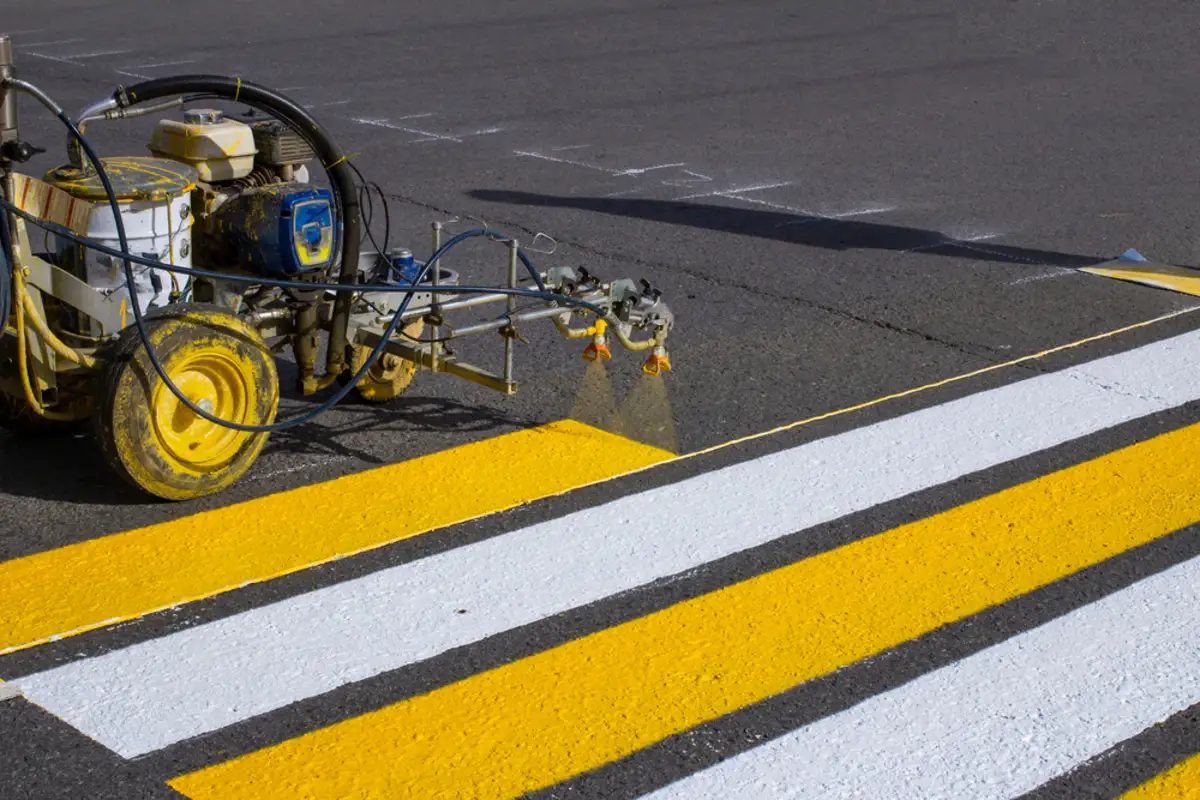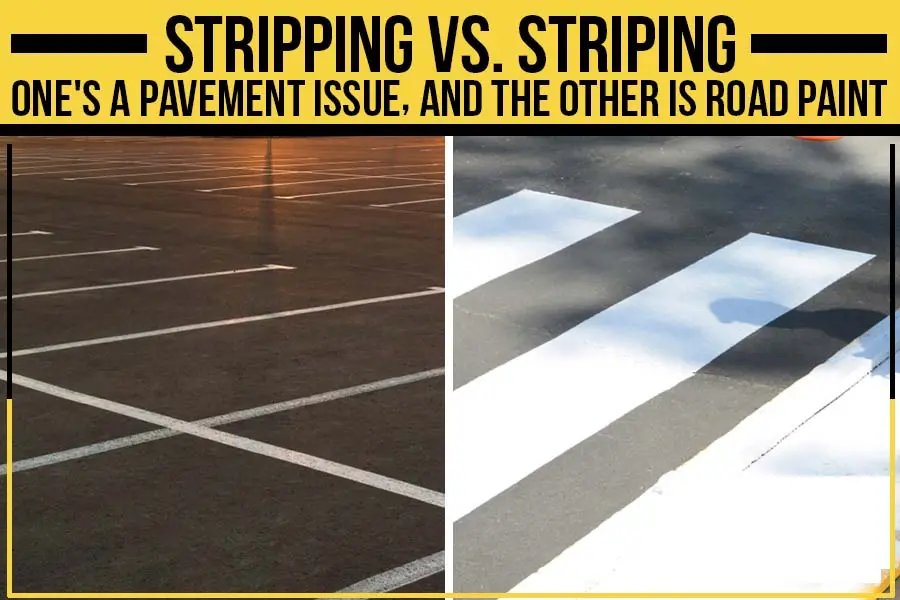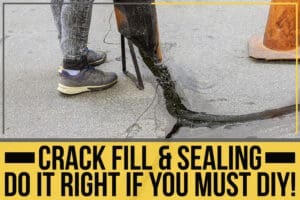Key Takeaways:
- Asphalt stripping is the process of reverse raveling, where the lower layers of asphalt disintegrate and harm the higher layers.
- Water availability or poor drainage is the primary reason for asphalt stripping.
- To handle asphalt stripping, an expert should evaluate the problem and take a core sample to determine if stripping is present.
- Striping is the application of pavement markings to surfaces so that people know where to park or take a turn.
- Proper pavement striping aids in safe navigation for automobiles and pedestrians and increases efficiency by reducing congestion.
When you hear the words “stripping” and “striping,” you might think of the same thing. After all, it’s easy to mix up these two similar-sounding words!
However, stripping and striping is very different regarding paving and asphalt maintenance. One is a pavement issue that requires regular maintenance, while the other involves road markings and thermoplastics. In this blog, Landmark will take a closer look at the difference between stripping and striping.
Stripping – What it Is
Asphalt stripping is essentially reverse raveling. Instead of the surface degrading and revealing the bottom layers, the lower layers of asphalt disintegrate first and harm the higher layers.
In more scientific words, the bottom of the asphalt layer’s aggregate elements and asphalt binder begin to separate, causing the asphalt to lose fundamental support and collapse upwards. This can pose major problems for the entire pavement layer by reflecting cracks to the surface or causing large areas to break quickly. Common signs include rubbing, pushing, raveling, and substantial cracking.
What Factors Contribute to Asphalt Stripping?
In a nutshell, water.
Moisture at the asphalt layer’s bottom can cause some aggregates to separate from the oil-based binding chemicals that hold the asphalt together. While inadequate asphalt mixes may add to the problem, water availability or poor drainage will be the primary reason.
Understanding Aggregate Surface Chemistry
In general, some aggregates prefer water over asphalt (hydrophilic). These aggregates are acidic and prone to peeling when exposed to water. On the other hand, some aggregates prefer asphalt over water (hydrophobic). These aggregates are usually simple and do not have stripping issues. Furthermore, when an aggregate comes into touch with water, its surface charge affects its adherence to asphalt cement and its susceptibility to moisture damage. To summarize, aggregate surface chemistry appears to be a significant component in stripping.
How To Handle Asphalt Stripping?
Since stripping occurs under the surface, it might be difficult to identify it as the primary cause. Various factors might cause the visual signs of asphalt distress; thus, an expert should evaluate the problem.
Finally, a core can be taken to enable physical access to the complete pavement width. If stripping is discovered, the pavement must be restored with modifications to eliminate the moisture penetration that produced the stripping in the first place.
Maintenance:
It’s essential to continuously monitor your pavement surface for signs of stripping because it can cause significant damage that requires costly repairs if left untreated. Regularly scheduled maintenance can prevent this from happening and help extend the life of your pavement surface. This will also help boost ROI since it costs less to maintain a well-maintained asphalt surface than to repair a neglected one.
Pavement Striping – What it Is
Striping is the application of pavement markings to asphalt or concrete surfaces so that people know where to go and what to do. This includes thermoplastics, paints, and preformed tapes, which mark traffic lanes, special areas like bike paths, and even pedestrian crosswalks.
Why Is a Good Striping Job Important?
- Safety
Proper pavement striping aids in the safe navigation of both automobiles and pedestrians. A neatly marked crossing will be difficult to miss, reducing the likelihood of an accident. Pavement markers (typically arrows) are also necessary for guiding one-way traffic flow throughout your area. Your objective should be to provide distinct visual messaging for passengers in and out of vehicles.
- Increases Efficiency and Accessibility
Striping can have a huge impact on the efficiency of traffic flow. Using striping to create narrower lanes and guide traffic helps enforce speed limits, reduce congestion, and make road travel safer. Asphalt striping also helps you maximize your pavement area by creating more usable vehicle space without compromising safety or adding extra paving costs. Asphalt striping can also help you comply with ADA standards for creating accessible walkways and parking spots.
- Cost-Effectiveness
Striping comes at a low cost but provides a large return on investment. Asphalt striping is much less expensive than other road maintenance methods and signals the professionalism of your business or organization. As a bonus, it also helps preserve the pavement by preventing vehicles from veering off roads and causing excess damage.
- Increases Curb Appeal
Pavement striping is necessary for guiding traffic and can also be used aesthetically to make your area look more appealing. With the right design and color choice, you can add charm to your pavement and create an inviting atmosphere for customers or visitors. Asphalt striping can also serve as a wayfinding guide by creating boundaries and lanes.
Methods To Apply Road Striping:
The process of applying road striping markings is determined by the type of paint used. Some tasks require reflective paint, while others may be completed using oil or water-based paints. Reflective paints are frequently thermoplastic and have a reputation for being among the most durable alternatives available.
Thermoplastic paints are heated before or during application to attach to the asphalt, whereas oil fully- and water-based paints are applied more simply. Spray dispensers are commonly used for spraying wider lines or curbs. Still, a few other marks may necessitate using tape or stencils to make the necessary shape.

Thermoplastic Striping Is the Best!
Pigments, binders, fillers, and glass beads make up thermoplastic striping material.
Typical applications include:
- Highways with heavy traffic
- Runway markers on the pavement
- Large Parking lots
It is chosen over normal paint for its longevity, strength, and nighttime reflectivity. The glass beads in the thermoplastic substance make pavement and road markings shiny and visible at night. Because no curing time is necessary, thermoplastic striping is also ready to use practically immediately.
However, it is best to leave thermoplastic striping to the professional as there are several things to consider during its application.
Property owners in Orlando can take help from Landmark. We are the leader in delivering high-quality striping services that can help you attract and retain consumers. We’ll discover the ideal solution for your needs, whether you need to identify a single spot or an entire parking lot.




